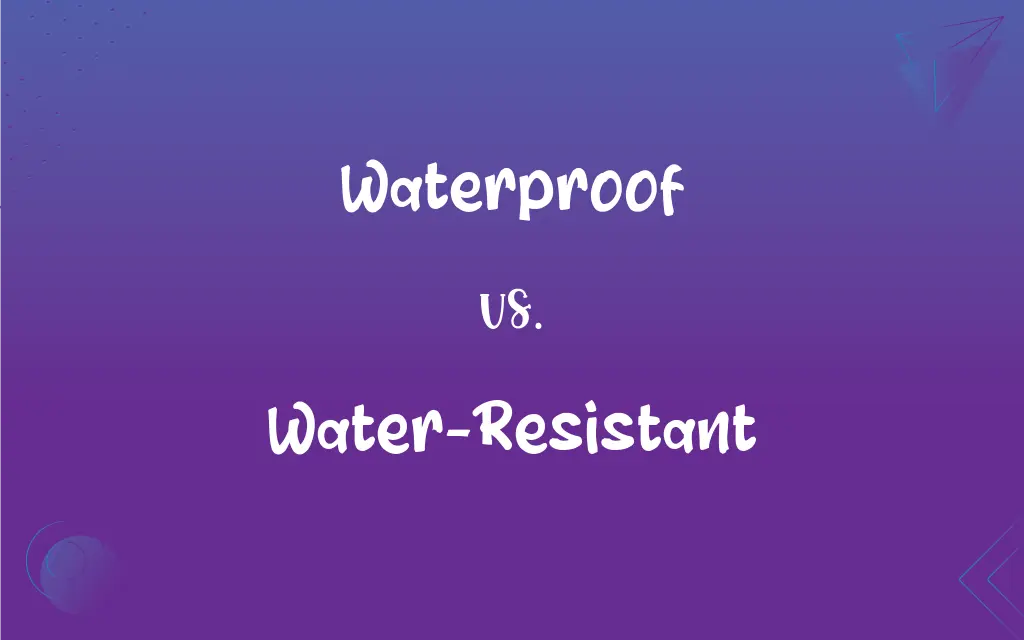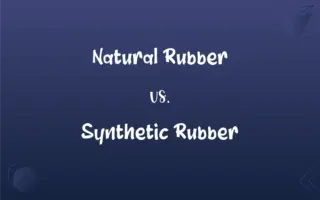Waterproof vs. Water-Resistant: What's the Difference?
Edited by Aimie Carlson || By Harlon Moss || Updated on October 23, 2023
Waterproof vs. Water-resistant: Waterproof means completely impervious to water, while water-resistant denotes some level of protection against water.

Key Differences
Waterproof and water-resistant are terms commonly used to describe the degree of protection a product has against water. Waterproof indicates that a product is entirely impervious to water and can typically remain submerged without allowing water to penetrate. On the other hand, water-resistant implies that a product can repel water to some extent, but not entirely.
When a product is labeled waterproof, it is often expected to withstand longer durations of water exposure without damage. Devices like watches or cameras might be rated waterproof up to certain depths and durations. Conversely, water-resistant items may only be designed to handle splashes, brief rain showers, or minimal moisture contact.
Materials or garments described as waterproof are often sealed with special treatments or barriers that completely prevent water intrusion. This contrasts with water-resistant items, which may only have a surface treatment or weave that repels water but doesn't block it entirely.
Consumers often mix up waterproof and water-resistant, expecting the latter to offer complete protection against water. However, while a water-resistant jacket might handle light rain, a waterproof jacket would be suitable for torrential downpours. Always checking labels and understanding these terms is crucial when purchasing products where water exposure is a concern.
Comparison Chart
Definition
Completely impervious to water
Offers some level of protection against water
ADVERTISEMENT
Typical Use
For prolonged exposure or submersion in water
For brief or minimal water exposure
Protection Level
Complete protection
Limited protection
Example Items
Diving watches, underwater cameras
Light rain jackets, water-repellent sprays
Durability in Water Exposure
Can withstand longer durations and depths
Designed for splashes or short durations
Waterproof and Water-Resistant Definitions
Waterproof
Completely impervious to water.
I bought a waterproof camera for my snorkeling trip.
ADVERTISEMENT
Water-Resistant
Designed to repel water to a certain degree.
My water-resistant jacket is perfect for light rain.
Waterproof
Sealed to prevent water intrusion.
I need a waterproof cover for my phone at the beach.
Water-Resistant
Provides a level of protection against moisture.
The water-resistant material prevented the bag's contents from getting wet.
Waterproof
Capable of being submerged without damage.
This waterproof watch can go up to 100 meters deep.
Water-Resistant
Can endure brief water exposure without damage.
I have a water-resistant watch, but I avoid submerging it.
Waterproof
Designed to remain unaffected by water.
The waterproof boots kept my feet dry during the storm.
Water-Resistant
Offers limited protection against water.
The water-resistant coat is good for drizzles but not heavy rain.
Waterproof
Able to resist the penetration of water.
The document is printed on waterproof paper to endure rain.
Water-Resistant
Treated to resist water but not impervious.
These shoes are water-resistant, so they're okay for dewy mornings.
Waterproof
Impervious to or unaffected by water.
Water-Resistant
Resistant to damage by water
A water-resistant watch.
Water-resistant wallboard.
Water-Resistant
That slows the penetration of water (but is not waterproof)
Water-Resistant
Hindering the penetration of water;
A water-repellent coat
FAQs
Can waterproof items be submerged?
Typically, waterproof items can be submerged without allowing water to penetrate, up to certain depths and durations.
What does waterproof mean?
Waterproof indicates a product is entirely impervious to water.
What does water-resistant mean?
Water-resistant denotes a product's ability to repel water to some degree but not entirely.
Are water-resistant products safe for prolonged water exposure?
No, water-resistant products are designed for brief or minimal water exposure.
Why might someone prefer water-resistant over waterproof?
Water-resistant products often provide breathability, making them more comfortable in certain conditions than waterproof ones.
Do all waterproof items float?
No, being waterproof doesn't mean an item will float; they are two different properties.
Is there a big price difference between waterproof and water-resistant products?
Generally, waterproof products can be more expensive due to the higher level of protection they offer, but prices vary based on other factors as well.
Do waterproof products wear out over time?
Some waterproof treatments or barriers can degrade over time, reducing their efficacy.
How are products tested for being waterproof or water-resistant?
Products undergo specific tests, like submersion or water jet exposure, to determine their water resistance levels.
How can I care for my waterproof gear?
Cleaning and occasionally reapplying waterproofing treatments can maintain the gear's effectiveness.
How long can a water-resistant watch be exposed to water?
It varies by product, but generally, water-resistant watches should avoid prolonged exposure and submersion.
What happens if a water-resistant device is submerged?
The device may get damaged as water-resistant doesn't mean it's designed for submersion.
Can I make a water-resistant item waterproof?
It's challenging to convert a water-resistant item to be truly waterproof; they are designed differently.
Is a waterproof jacket the same as a water-resistant one?
No, a waterproof jacket offers complete protection against water, while a water-resistant one offers limited protection.
Can I swim with a waterproof watch?
Depending on its rating, a waterproof watch can be used for swimming, but always check the manufacturer's guidelines.
Are there different grades of water-resistance?
Yes, some products have ratings that specify the degree of water-resistance they offer.
Can water-resistant shoes handle deep puddles?
It depends on the shoe's design, but typically they are made for light moisture, not deep water exposure.
Which is better for hiking: waterproof or water-resistant?
It depends on the conditions. For heavy rain or crossing streams, waterproof is better, but for light rain or breathability, water-resistant might be preferred.
How can I make a product water-resistant?
Some sprays and treatments can make materials water-resistant, but it won't make them waterproof.
Is water-resistant the same as splash-proof?
Both terms indicate some water protection, but "splash-proof" typically suggests even less protection than "water-resistant."
About Author
Written by
Harlon MossHarlon is a seasoned quality moderator and accomplished content writer for Difference Wiki. An alumnus of the prestigious University of California, he earned his degree in Computer Science. Leveraging his academic background, Harlon brings a meticulous and informed perspective to his work, ensuring content accuracy and excellence.
Edited by
Aimie CarlsonAimie Carlson, holding a master's degree in English literature, is a fervent English language enthusiast. She lends her writing talents to Difference Wiki, a prominent website that specializes in comparisons, offering readers insightful analyses that both captivate and inform.
































































